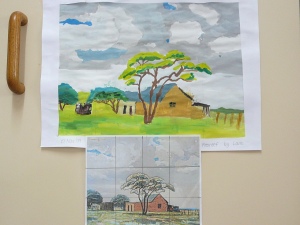Art Appreciation Lesson
Charlotte Mason recommends that children study an artist and several of his works over a periodof weeks so that they can recognize his paintings and appreciate his style or subject. After detailed observation they should narrate all they remember seeing in the painting they studied and this encourages detailed study!
We studied a famous South African artist Jacob Hendrick Pierneef and googled images of his works. Each child selected their favourite painting I printed for them. We measured and drew a grid on the printed work and sketched the painting. We used acrylic paints to paint our pictures. Here are our versions of Pierneef:
My eldest dd (14-years-old) is completing her Footprints Into The 21st Century (South African Literature-Based History Curriculum) and her last section requires the study of famous South African sports and arts personalities. She selected Pierneef and wrote this essay:
South African Artist: Jacob Hendrik Pierneef
J.H. Pierneef is considered one of South Africa’s most talented and original artists. He enjoyed painting South Africa’s highveld landscapes and had a technique that was very stylized and graphic. His style was different from all other South African artists in his day, and his works greatly attracted attention.
Jacob Hendrik Pierneef was born in Pretoria in 1886 and he came from a Dutch background. He started studying art in high-school in South Africa, but due to the 2nd Boer War, his family moved back to the Netherlands.
When he returned to South Africa, he met and learned much about graphic techniques from other great South African artists. In 1913, Pierneef held his first solo exhibition and his artwork was very well received. The viewers were all exceedingly impressed by his dramatic talent. From then on he became very well known and his works proved to be successes.
In 1918 Jacob Pierneef started a new a career and became an art lecturer and started to teach drawing in the Heidelberg Collage of Education. When he began to teach art, Pierneef discovered that most of the South Africa’s landscape artwork was drawn in the British style, an unrealistic and romanticized vision of South Africa. He then decided to draw attention to the uniqueness of South Africa’s highveld. He created a style that was dramatic, structural and graphic and was distinctively recognized as a South African style. He believed strongly in the cause of Afrikaner art and culture.
(She then chose and printed 4 of paintings she most enjoyed.)
When children use Charlotte Mason’s approach, they almost “own” the painting they reproduce! I have even heard them say, “There’s my picture of the … (Milkmaid by Vermeer)!” when they see the painting in a book or movie or magazine.
Has this form of Art Appreciation been a success for your children?




Pingback: Hands-on Artist Study: Making Reproductions - The End In Mind
Pingback: Hands-on Artist Study: Making Reproductions | Heart of the Matter Online - bridging the gap between child and parent
I really enjoy the paintings your children did. It looks like they took their time viewing their subject and I can see the pride they took in their work. Great work!
LikeLike
Thanks – yes it does take time to really look, compare and find the details in art! 🙂
LikeLike
Wonderful, Nadene! The similarities between the original and their reproductions are really striking. I’m curious as to how many hours they worked on the sketches and paintings.
LikeLike
Hi Jimmie, We spent most the day on this project; in the morning each chose a favourite painting, then we drew grid lines and copied the outlines of the picture. We painted the rest of the day. We painted sky and clouds first, then distant background before doing Pierneef’s famous trees!
LikeLike
They are just beautiful!
We haven’t done enough painting here. It’s not my forte’, but I need to overcome the wanting to try so my children will more often have a go.
Well, it’s summer here and we’ve plenty of time to practice, I believe.
Thanks for sharing.
Great job everyone. 🙂
LikeLike
Those are beautiful paintings! I’ve never tried using a grid for painting impressions
LikeLike
Art grids help one copy in proportion and enlarge a picture. You compare the lines and shapes that cross the gird lines … but it takes practice 🙂
LikeLike